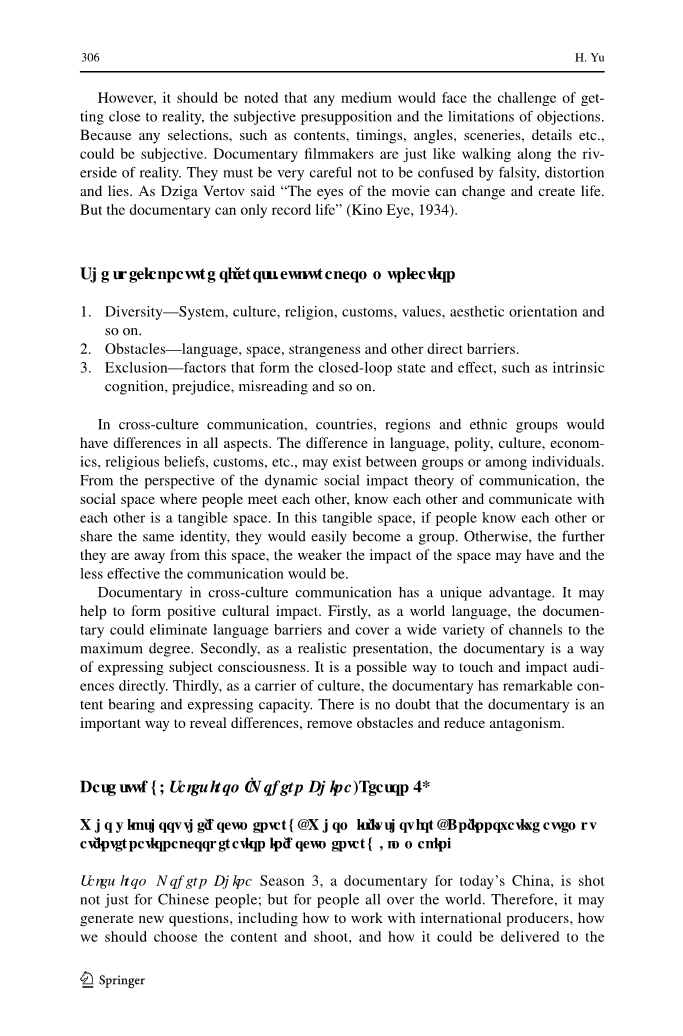中国纪录片的传播和文化影响——《现代中国的故事》案例研究
摘要:纪录片已经成为全世界观众都能理解的一种语言。它是一种独特的视觉表达方式,对跨文化交流有积极影响。文化交流有不同的方式,而纪录片是接近来自不同国家、民族、地区或其他多种背景的人的最佳方式之一。
一、纪录片的传播和审美的特点
1. 纪录片可以被看作是一种视频节目模式。内容的选择和视觉呈现都是基于现实的。
2. 纪录片具有表现视觉和听觉的巨大能力。
3. 纪录片可以涵盖大量的主题和深刻的内涵。
4.由于纪录片的可视性、可感性和模糊性,观众可以在一定程度上跨越语言障碍。
5. 在互联网时代,纪录片传播和观看的便利性更加突出。
一句话,人类艺术创作的关键原动力就是要还原生活的本质。而纪录片创作的艺术手段就是要尽可能地贴近现实。因此,重视世界的原始形态和主体的真实性,是每一个纪录片制作者的基本追求。这也是纪录片之所以有魅力的主要原因。
然而,应该注意的是,任何媒介都会面临接近现实的挑战,主观的预设和反对的限制。因为任何选择,如内容、时间、角度、景物、细节等,都可能是主观的。纪录片制作者就像在现实的河边行走。他们必须非常小心,不要被虚假、歪曲和谎言所迷惑。正如Dziga Vertov所说 '电影的眼睛可以改变和创造生活。但纪录片只能记录生活'(Kino Eye,1934年)。
二、跨文化交流的特殊性质
1. 多样性——制度、文化、宗教、习俗、价值观、审美取向等等。
2. 障碍——语言、空间、陌生感和其他直接障碍。
3. 排斥——形成闭环状态和影响的因素,如内在的认知、偏见、误读等。
在跨文化交流中,国家、地区和民族在各方面都会有差异。语言、政体、文化、经济、宗教信仰、习俗等方面的差异,可能存在于群体之间或个人之间。从传播的动态社会影响理论的角度来看,人们相互见面、相互认识、相互交流的社会空间是一个有形的空间。在这个有形的空间里,如果人们互相认识或有相同的身份,他们就会很容易成为一个群体。否则,他们离这个空间越远,空间的影响就越弱,沟通的效果就越差。
纪录片在跨文化交流中具有独特的优势。它可以帮助形成积极的文化影响。首先,作为一种世界性语言,纪录片可以消除语言障碍,最大程度地覆盖各种渠道。其次,作为一种现实的表现形式,纪录片是表达主体意识的一种方式。它是一种可能直接触动和影响观众的方式。第三,作为文化的载体,纪录片具有显著的内容承载和表达能力。毋庸置疑,纪录片是揭示差异、消除障碍、减少对立的一种重要方式。
三、案例研究:《现代中国的故事》(第三季)
(一)谁来拍摄这部纪录片?为谁拍摄?纪录片制作中国际合作的创新尝试
《现代中国的故事》第三季是一部为当今中国拍摄的纪录片,它不仅仅是为中国人拍摄的;而是为全世界的人拍摄的。因此,它可能会产生新的问题,包括如何与国际制片人合作,我们应该如何选择内容和拍摄,以及如何将它传递给观众?通过回答这些问题,我们希望能使我们的主题得到理解和更有意义。
这部六集的纪录片由江苏广电合作投资,与英国狮子电视台合作,于2017年6月3日至7月8日首次播出。它的全球首播是在江苏电视台和BBC世界新闻频道进行的。早期的第一季(36集)于2014年9月推出;第二季(15集)于2015年底推出。第三季进行了国内省级广播电视机构与国际电视网络相结合的创作,试图探索一种新的模式,向全球观众讲述不为人知的中国故事和传说。
(二)拍什么和怎么拍?主题和制作为中国纪录片走向世界铺平道路
主题选择:充满中国特色的中国故事,具有最新的、活泼的、生动的面貌。无论故事是否为观众所熟悉。例如,《旗袍的故事》包括旗袍的历史和美学,以及当前年轻设计师的生活方式。这是一个传统的故事,其中有一些时尚和现代的宠儿,代表了年轻人对传统的继承和他们的创新。这个故事旨在向西方观众展示当代中国的积极精神和生活方式。
表达:主持人同时来自中国和英国。中国纪录片中的外国主持人会帮助国外观众探索和采访他们的观点,增加沉浸感、真实性和可信度。这部纪录片中的表达方式和配音都是为了符合西方观众的观看习惯。制片人与外国导演反复讨论,使其表达方式更容易被接受。
结构:每一集都被切割成一个清晰的段落,这很容易被理解。这也满足了所谓的碎片化互联网上的交流要求。制作人对技术和艺术方面给予了很大的关注。与第一季相比,第三季有了很大的不同。
(三)如何播出,效果如何?拓展传播渠道,国内同步向国外播出
国内播放平台:纪录片的首播在江苏电视台,江苏广播电视台的荔枝新闻也将同时播出。
国外的广播平台:实现了BBC与国内同步播出的目标,帮助西方观众更好地了解中国。它最大限度地发挥了国际传播的效果,显示了主流媒体的责任。试图将有限的传播形式的影响最大化,使国际传播更加有力和有效。
总而言之,《现代中国故事》(第三季)为国际文化传播做出了积极的贡献,并成为国际文化传播的典范,为中国文化在世界范围内实现了最大的地域覆盖和传播效果。
外文文献出处:Yu, H. The communication and cultural influence of Chinese documentary: a case study of Tales from Modern China. Int. Commun. Chin. Cult 5, 305–308 (2018). https://doi.org/10.1007/s40636-018-0135-4
附外文文献原文:
The communication and cultural influence of Chinese documentary: a case study of Tales from Modern China
Hong Yu[2]
Received: 18 December 2017 / Revised: 19 May 2018 / Accepted: 20 September 2018 / Published online: 17 November 2018 copy; Academy for International Communication of Chinese Culture and Springer-Verlag GmbH Germany, part of Springer Nature 2018
The documentary has become a language which can be understood by audiences all around the world. It is a unique visual expression which has a positive impact on cross-culture communication. There are different ways of cultural communication and the documentary is one of the best ways to approach people from different countries, nations, regions or other multiple backgrounds.
Characteristics of the communication and aesthetics of documentary
1. The documentary can be seen as a sort of video program mode. The selections of content and visual presentations are based on reality.
2. The documentary has a great capacity of representing vision and acoustics.
3. The documentary could cover plenty of themes and deep connotations.
4. Because of the visual, sensible and affluent nature of the documentary, the audiences can stride over language obstacles to a certain degree.
5. The convenience of documentary communication and viewing is more prominent in the Internet age.
In a word, the crucial original power of human art creation is to restore the nature of life. And the artistic means of documentary filmmaking is to get close to reality as much as possible. Therefore, attaching importance to the original shape of the world and authenticity of the subjects is the essential pursuit of every documentary filmmaker. That is also the main reason why the documentary is charming.
However, it should be noted that any medium would face the challenge of getting close to reality, the subjective presupposition and the limitations of objections. Because any selections, such as contents, timings, angles, sceneries, details etc., could be subjective. Documentary filmmakers are just like walking along the riverside of reality. They must be very careful not to be confused by falsity, distortion and lies. As Dziga Vertov said “The eyes of the movie can change and create life. But the documentary can only record life” (Kino Eye, 1934).
The special nature of cross‑cultural communication
1. Diversity—System, culture, religion, customs, values, aesthetic orientation and so on.
2. Obstacles—language, space, strangeness and other direct barriers.
3. Exclusion—factors that form the closed-loop state and effect, such as intrinsic cognition, prejudice, misreading and so on.
In cross-culture communication, countries, regions and ethnic groups would have differences in all aspects. The difference in language, polity, culture, economics, religious beliefs, customs, etc., may exist between groups or among individuals. From the perspective of the dynamic social impact theory of communication, the social space where people meet each other, know each other and communicate w
剩余内容已隐藏,支付完成后下载完整资料


英语原文共 4 页,剩余内容已隐藏,支付完成后下载完整资料
资料编号:[595079],资料为PDF文档或Word文档,PDF文档可免费转换为Word
课题毕业论文、文献综述、任务书、外文翻译、程序设计、图纸设计等资料可联系客服协助查找。


